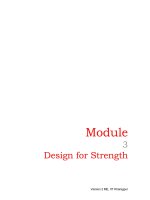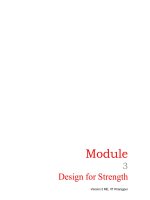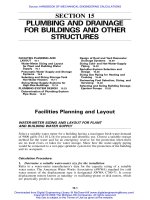Tài liệu NOMENCLATURE OF ORGANIC COMPOUNDS docx
Bạn đang xem bản rút gọn của tài liệu. Xem và tải ngay bản đầy đủ của tài liệu tại đây (548.44 KB, 15 trang )
1
NOMENCLATURE OF ORGANIC COMPOUNDS
©2010, 2003, 1980, by David A. Katz. All rights reserved.
Organic chemistry is the chemistry of carbon compounds. Carbon has the ability to bond with itself to
form long chains and, as a result, millions of compounds from simple hydrocarbons to large
biomolecules such as proteins, lipids, carbohydrates, and nucleic acids. Originally it was believed that
these compounds had to come from a living organism, now they are synthesized in the laboratory.
The simplest organic compounds are composed of carbon and hydrogen and are known as hydrocarbons.
There are four types, or classes, of hydrocarbons:
Alkanes: contain all C-C single bonds. These are known as saturated hydrocarbons.
Alkenes: contain at least one C=C double bond.
Alkynes: contain at least one C≡C triple bond. Both alkenes and alkynes are known as
unsaturated hydrocarbons
Aromatic hydrocarbons: contain a benzene structure
Lewis structures of alkanes look like this:
These are also called structural formulas. Since these take up a lot of space, condensed structural
formulas are used.
Even simpler than condensed structures are skeletal or line structures:
There are a range of structures used to represent organic compounds:
Before we start naming organic compounds, it is important to understand how carbon atoms are bonded.
Every carbon atom will try to form 4 bonds.
A carbon atom on the end of a chain of single bonded carbon atoms will be bonded to
one carbon atom and three hydrogen atoms:
H
C C H
H
2
A carbon atom in the middle of a chain of single bonded carbon atoms will be
bonded to two carbon atoms and two hydrogen atoms.
A carbon atom bonded to 3 other single bonded carbon atoms will be bonded to one
hydrogen.
A carbon atom on the end of a chain that is double bonded to another carbon atom be
bonded to two hydrogen atoms.
A carbon atom in the middle of a chain of that is double bonded to another carbon
atom will be bonded to one carbon atom and one hydrogen atom.
A carbon atom on the end of a chain that is triple bonded to another carbon atom
will be bonded to one hydrogen atom. The second carbon atom in that chain is only
bonded to another carbon atom, but no hydrogen atoms.
I. Naming Saturated Hydrocarbons - The Alkanes
The names of the alkanes are derived from the Greek prefix for the particular number of carbon atoms
in the compound with an -ane ending. The names of the first ten alkanes are given in the following
table.
H
C C C
H
C C C
C
H
C C
\
H
H
C C C
H
H H
C C C C
C C C H
3
Not all the alkanes are straight chained compounds, as shown in the previous table, they can have side chains or
branches. These variations of compounds which have the same number of carbon and hydrogen atoms, but a
different arrangement are known as isomers. Some isomers are shown in the diagram below.
Rules for Naming of Branched Hydrocarbons.
There are four parts to the name of a branched hydrocarbon
1. The parent chain: Tells how many carbons are in the longest continuous chain.
meth = 1 eth = 2 prop = 3 but = 4 pent = 5
2. The suffix: Tells what type of compound it is.
ane = an alkane ene = an alkene yne = an alkyne
3. The prefix: Tells what groups, or branches are attached to the parent chain.
methyl = CH
3
ethyl = CH
2
CH
3
propyl = CH
2
CH
2
CH
3
4. The location: Tells where groups, or branches, are attached to the parent chain.
2 = 2
nd
carbon atom 3 = 3
rd
carbon atom 4 = 4
th
carbon atom
Note: alkyl groups, or branches cannot be located on the 1
st
or last carbon
4
Example 1:
CH
3
-CH-CH
2
-CH-CH
3
CH
3
CH
3
1. Select as the parent chain the LONGEST CONTINUOUS CHAIN of carbon atoms. The
compound is considered to have been derived from the parent structure by the replacement of
hydrogens by various alkyl groups.
CH
3
-CH-CH
2
-CH-CH
3
CH
3
CH
3
The longest continuous chain of carbon atoms in this example contains five carbon atoms.
Since the carbon atoms in this compound all contain The alkane that contains five carbon
atoms is pentane.
2. Identify the branches, or side chains, attached to the parent chain.
CH
3
-CH-CH
2
-CH-CH
3
CH
3
CH
3
Both branches consist of single carbon atoms, there are called methyl groups
3. Starting from either end of the longest carbon chain, number the carbon atoms in the parent
chain consecutively so that the alkyl groups (or branches) are attached to the carbon atoms
with the lowest possible numbers.
1 2 3 4 5
CH
3
-CH-CH
2
-CH-CH
3
CH
3
CH
3
For this compound, it makes no difference which end you start the numbering. In both
cases the alkyl groups, or branches are attached to the second and fourth carbon atoms in
the parent chain.
4. Name the compound in order of: number of carbon atom-alkyl group attached(number of
carbon atom-alkyl group attached- etc ) name of parent compound. If there are several
different alkyl groups attached to the parent chain, name them in order of increasing size or
in alphabetical order.
The name for this compound looks like it would be called would be called 2-methyl-4-
methylpentane, however, all branches with the same name are grouped together. The
number of these branches have a prefix:
di = 2 tri = 3 tetra = 4 penta = 5
But, each branch needs a specified location, so, the correct name is 2,4-dimethylpentane
5
Example 2
CH
3
CH
3
CH
3
- CH-CH
2
-CH-CH-CH
2
-CH
3
CH
2
-CH
2
-CH
3
In this compound, the longest continuous chain is 8 carbon atoms long. Note that the
longest continuous chain does not have to be straight. This longest chain is oct- (for 8
carbons)
All the bonds are single bonds, so this is an alkane. The suffix is -ane
This parent chain is octane
CH
3
CH
3
CH
3
- CH-CH
2
-CH-CH-CH
2
-CH
3
CH
2
-CH
2
-CH
3
There are three branches attached to the parent chain. Two of these are methyl groups
and one is an ethyl group.
Number the carbon atoms, so that the groups are attached to the carbon atoms with the
lowest possible numbers.
CH
3
CH
3
CH
3
- CH-CH
2
-CH-CH-CH
2
-CH
3
1 2 3 4 5
CH
2
-CH
2
-CH
3
6 7 8
The two methyl groups in this compound are attached on the 2
nd
and 4
th
carbon atoms and
the ethyl group is attached to the 5
th
carbon atom.
This compound is named 5-ethyl-2,4-dimethyloctane. Note that the branches are named
in alphabetical order.
II. Naming Unsaturated Hydrocarbons – Alkenes and Alkynes
Rules for Naming Alkenes and Alkynes
Alkenes contain at least one carbon to carbon double bond. The suffix used is –ene.
Alkynes contain at least one carbon to carbon triple bond. The suffix used is –yne.
6
Naming is the same as used for alkanes, except that the parent structure is the longest continuous
chain of carbon atoms that contains the carbon-carbon double bond or triple bond. The name is
derived by changing the suffix of the corresponding alkane name to –ene for an alkene and –yne for
an alkyne and a number is added to denote the location of the multiple bond.
Example:
CH
3
CHCHCH
3
The longest continuous chain in this compound contains four carbon atoms. The parent
structure would be named but + ene (to denote the double bond)
Number the carbon atoms in' the longest chain in such a way that the carbon atoms
containing the double bond have the lowest possible numbers.
1 2 3 4
CH
3
CHCHCH
3
For this compound, the numbering should start on the left side so the double bond will be
located between carbon atom no. 2 and carbon atom no. 3. Although the double bond involves
two carbon atoms, its position is designated by the number of the first doubly-bonded carbon
atom when numbering from the end of the parent chain nearest the double bond. So, this
compound would be named 2-butene.
Example:
CH
3
CH
2
CH=CH
2
In this compound the double bond is located between the 1
st
and 2
nd
carbon atoms.
The compound is named 1-butene.
Example:
CH
3
CHCHCH=CH
2
The longest continuous chain in this compound contains five carbon atoms. The parent
structure would be named pent- however, the compound contains two carbon-carbon double
bonds. The number of double bonds, if greater than 1, is denoted by a prefix added to the
suffix.
di = 2 tri = 3 tetra = 4
The p[aren’t chain is named pentadiene Note that an “a” is added to the name to make it easier
to pronounce.
Number the carbon atoms in' the longest chain in such a way that the carbon atoms containing
the double bond have the lowest possible numbers.
5 4 3 2 1
CH
3
CHCHCH=CH
2
For this compound, the numbering should start on the right side so the double bonds will be
located between carbon atom no. 1 and carbon atom no. 2 and carbon atom no. 3 and carbon
atom no. 4. The name of the compound is 1,3-pentadiene
7
Example
CH
3
CH
2
CCH
The longest continuous chain in this compound contains four carbon atoms. The parent
structure would be named but + yne (to denote the triple bond)
Number the carbon atoms in' the longest chain in such a way that the carbon atoms containing
the triple bond have the lowest possible numbers.
4 3 2 1
CH
3
CH
2
CCH
For this compound, the numbering should start on the right side so the triple bond will be
located between carbon atom no. 1 and carbon atom no. 2. This compound would be named 1-
butyne.
If the compound is branched, the name is determined similar to that used for the alkanes.
Example. CH
3
-CH-CH=CH-CH
3
CH
3
This compound is named 4-methyl-2-pentene. Note that the double bond takes precedence in
naming.
III. Naming Aromatic Compounds
Aromatic Compounds are cyclic hydrocarbons containing a benzene structure.
Benzene can be represented by the resonance structures:
The actual structure of benzene, however, is a resonance hybrid of these two structure
usually written as:
8
Benzene rings can be fused together. These compounds have common names.
Naphthalene Anthracene
An aromatic compound which is formed by having an alkyl group attached to a benzene ring
is named by prefixing the alkyl group name to the word benzene. An example of this is
named methylbenzene or toluene
If there are only two groups attached to the benzene ring, their relative positions can be
designated by numbers or by the terms ortho,
meta. or para, abbreviated o-, m-, or p
1,2-dinitrobenzene 1,3-dinitrobenzene 1,4-dinitrobenzene
ortho-dinitrobenzene meta-dinitrobenzene para-dinitrobenzene
Ortho = the 1 and 2 positions on the ring (adjacent carbon atoms)
Meta = the 1 and 3 positions on the ring (alternate carbon atoms)
Para = the 1 and 4 positions on the ring (opposite carbon atoms)
IV. Naming Functional Group Compounds
Derivatives are formed by replacing one or more of the hydrogens in a hydrocarbon by a
FUNCTIONAL GROUP. The functional group is responsible for giving what is ordinarily an
inactive compound the characteristic chemical and physical properties of another class of
compounds.
A. Halogen Derivatives of Hydrocarbons
Functional Group: - X (F, Cl, Br, I)
General Formula: R-X
Naming of Halides
Halogens attached to a hydrocarbon chain are named by replacing the -ine ending of the halogen
name with –o. When naming a compound, halogens are named in the same manner as alkyl group
branches.
9
Examples: Cl Br
CH
3
-Br CH
3
CH
2
-I CH
3
CHCH
3
CH
3
CH
2
CHCH
2
Br
bromomethane iodoethane 2-chloropropane 1,2-dibromobutane
B. Oxygen Derivatives of the Hydrocarbons
These functional group compounds contain at least one oxygen atom in its structure.
1. Alcohols
Functional Group: OH
General Formula: ROH
Naming of alcohols:
Number the-longest carbon chain so that the -OH group is attached to the carbon atom with the
lowest possible number. Name the parent compound by using the alkane name and replacing
the -e ending with an -ol ending. Indicate the position of the hydroxyl. group with a number in
any alcohol containing three or more carbon atoms.
Examples:
OH
CH
3
OH CH
3
CH
2
OH CH
3
CH
2
CH
2
OH CH
3
CHCH
3
methanol ethanol 1-propanol 2-propanol
(methyl alcohol) (ethyl alcohol) (propyl alcohol) (isopropyl alcohol)
Aromatic alcohols are called phenols and contain the structure:
2. Ethers
Functional Group: O
General formula: ROR
Naming of ethers
Ethers are commonly named by naming each group attached to the oxygen followed by the word
ether. If one group has no simple name, the ether can be named as an alkoxy
derivative of the
larger group.
Examples:
CH
3
-O-CH
3
CH
3
-O-CH
2
CH
3
CH
3
CH
2
-O-CH
2
CH
3
dimethyl ether methyl ethyl ether diethyl ether
(methoxymethane) (methoxyethane) (ethoxyethane)
OH
10
3. Carbonyl Compounds
Carbonyl compounds all contain a O
This includes several types of compounds:
Aldehydes
Ketones
Carboxylic acids
Esters
Amides
a) Aldehydes
O
Functional Group: CH
O
General formula: RCH or shorthand as CHO (The oxygen is bonded to a terminal carbon
atom)
Naming of aldehydes:
Number the-longest carbon chain starting with the -CHO group. Name the parent compound by
using the alkane name and replacing the -e ending with an -al ending.
Examples:
O O
HCH CH
3
CH
methanal ethanal
(methyl aldehyde) (ethyl aldehyde also known as acetaldehyde)
b) Ketones
O
Functional Group: C
O
General formula: RCR (The oxygen is bonded to a carbon atom in the middle of the chain)
Naming of Ketones:
Number the-longest carbon chain starting so that the –C=O group is attached to the carbon atom
with the lowest number. Name the parent compound by using the alkane name and replacing the -
e ending with an -one ending.
11
Examples:
O O
CH
3
CCH
3
CH
3
CCH
2
CH
3
propanone 2-butanone
(dimethyl ketone or (methylethyl ketone)
acetone)
c) Carboxylic acids
O
Functional Group: COH
O
General formula: RCOH or shorthand as COOH (The carboxyl group is bonded to a terminal
carbon atom)
Naming of acids:
Number the-longest carbon chain starting with the -COOH group. Name the parent compound by
using the alkane name and replacing the -e ending with an –oic acid ending.
Examples:
O O
HCOH CH
3
COH
methanoic acid ethanoic acid
(formic acid) (acetic acid)
d) Esters
An ester is formed from the combination of a carboxylic acid and an alcohol. They are often
highly aromatic compounds and are used for flavors and fragrances.
O
Functional Group: CO
O
General formula: RCOR’ (The R’ may be the same or different from R)
Naming of esters
Esters are usually named by naming the R’ group [from an alcohol] as an akyl group first
followed by the acid name [the R-C group] with ending -oate. Esters are often called by their
common names.
Examples of esters and their flavor/odor properties are given in the table below.
12
Formula Common name IUPAC name Flavor/odor
O
HC-O-CH
2
-CH
3
ethyl formate
ethyl methanoate
rum
O
H
3
C-C-O-CH
2
-(CH
2
)
3
-CH
3
n-amyl acetate
pentyl ethanoate
pears, bananas
O
H
3
C-C-O-CH
2
-CH
2
-CH(CH
3
)
2
isoamyl acetate
3-methylbutyl ethanoate
pears, bananas
O
H
3
C-C-O-CH
2
-(CH
2
)
6
-CH
3
n-octyl acetate
octyl ethanoate
oranges
O
H
3
C-CH
2
-C-O- CH
2
-CH(CH
3
)
2
isobutyl propionate
2-methylpropyl propanoate
rum
O
H
3
C-CH
2
-CH
2
-C-O-CH
3
methyl butyrate
methyl butanoate
apples
O
H
3
C-CH
2
-CH
2
-C-O-CH
2
-CH
3
ethyl butyrate
ethyl butanoate
pineapples
O
H
3
C-CH
2
-CH
2
-C-O-CH
2
-(CH
2
)
2
-CH
3
n-butyl butyrate
butyl butanoate
pineapples
O
H
3
C-CH
2
-CH
2
-C-O-CH
2
-(CH
2
)
3
-CH
3
n-amyl butyrate
pentyl butanoate
apricots
O
H
3
C-(CH
2
)
3
-C-O-CH
2
-CH
2
-CH (CH
3
)
2
isoamyl valerate
3-methylbutyl butanoate
apples
C
HO
O
OH
3
C
methyl salicylate
methyl 2-hydroxybenzoate
oil of wintergreen
e) Amides
O
Functional Group: CN:
O
General formula: RCNH
2
13
Naming of Amides
Amides are commonly named similar to a carboxylic acid, replacing the –oic acid suffix with
amide.
Examples:
O O
HCNH
2
CH
3
CNH
2
formamide ethanamide
(methylamide) (ethylamide or acetamide)
A summary of the functional group compounds, their structures and names is listed in
tables on the next two pages.
14
15









